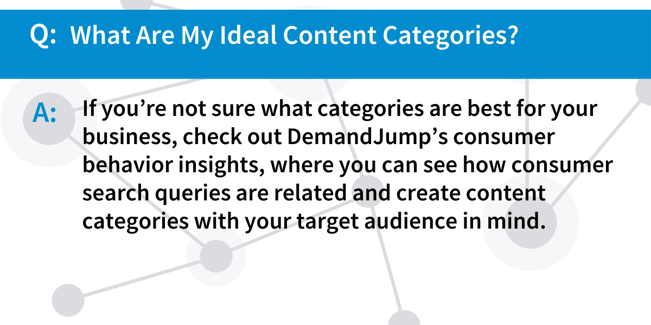What are Content Categories?
December 18, 2020 •Erica Kempf

Content marketing is chock full of buzzwords and lingo that can be hard to understand. Let’s take a look at content categories, also referred to as content buckets and help you understand what a useful tool they can be.
So, what are content categories? Essentially, content categories are an organizational structure to help you sort and distribute your content. This is primarily a high level view of your content and is meant to help you plan and execute your content marketing campaigns.
When creating content, you will have all sorts of different content formats, and having designated categories for that content can be extremely helpful. You can also think of them as content buckets—places to hold and store related content.
Why Use Content Categories?
Content categories are an important piece of your overall marketing strategy. When developing your content marketing strategy, content categories are used to fill out your calendar and make a plan. It is vitally important to use many different types of content marketing and to create a mixture of posts to keep your customer engaged. Not only that, but it is important to know not only what you are posting, but why you are posting it. Content categories help with this.
How Do I Create a Content Bucket?
There are a few different strategies, and you should experiment with what works best for you. Some people use content categories like:
- Case studies
- Photos
- Videos
- Blog Posts
While that can be slightly helpful from a logistics standpoint, this is essentially just separating content into their respective formats.
A more useful (and lucrative!) way to use content categories is to think about the purpose behind your posts. A good content marketing plan uses a broad range of topics and types of content. Using content categories can help you quickly identify and pull content to post.
Example of a Content Bucket Strategy
For example, a personal training company might want to set up content categories like:
- Health
- Training
- Inspiration
- Promotions
- Education
- Engagement
Then each content bucket can hold different types of content (videos, blog posts, podcast episodes) but all relating to that category. Here is a brief example of the types of posts that could fall under each category:
- Health
- Link to blog post about vitamins
- Podcast episode about personal health challenges
- Training
- Video series on 5 minute exercises
- Infographic about running
- Photo of gym setup
- Inspiration
- Client interviews (videos and podcasts)
- Quotes about fitness
- Promotions
- Group classes
- Holiday specials
- Education
- Gym etiquette blog post
- Video interview with a nutritionist
- Engagement
- Funny exercise mishap post - ask for their stories
- Water bottle giveaway
When it comes time to schedule posts for social media, you can fill out your calendar with the different types of posts that have different purposes—making sure that you have a good mix of formats (videos/podcasts/blogs) and purposes (health/education/engagement).
Some people use an even higher level of content categories and sort all their posts into 3 useful classification buckets for content. For example:
- SEO (Search Engine Optimization)
- Brand Awareness
- Sales and Engagement
These are broader categories that could hold many different types of posts and could even have sub-categories within them. You can see that this is a birds-eye view of content buckets compared to the other content categories example.
Content Categories Work for YOU!
Don’t feel constrained by finding the exact “right” content categories—you can have many different ones and change and adapt them as needed. Some people use categories that include holidays or recent trends and those categories may not be long term pieces of your content marketing strategy. If the buckets you have picked aren’t working for you, add different buckets! The point of content buckets is to help you think about your content in a different way and to identify the purpose of your content. Knowing what you have is key to making good content marketing decisions and seeing a return on your investment.
Figuring Out Your Ideal Content Categories
If you’re not sure what categories are best for your business, check out DemandJump’s consumer behavior insights. You can see how consumer search queries
are related and create content categories with your target audience in mind. You can see what your customers click on and what they respond to and use that data to develop and refine your content categories. Most importantly, you can see what content is working—and what is not. Our tools are like a map for your content strategy, guiding you towards content that engages and delights. Try DemandJump for free and experience the difference it makes in your content marketing campaigns.
Save over 50% of your time while creating better content - that ranks.
Featured Articles
Categories
- Attribution Tracking (13)
- Channel Optimization (11)
- Consumer Insights (68)
- Content Marketing (251)
- Data Science (8)
- Digital Marketing (6)
- Digital Transformation (26)
- Enterprise (10)
- Lead Generation (14)
- Market Intelligence (8)
- Marketing Analytics (39)
- Marketing Attribution (57)
- Marketing Management (153)
- Marketing Operations (86)
- Organic Search (222)
- Paid Search (52)
- Pillar-Based Marketing (63)
- Programmatic Advertising (9)
- SaaS Content (14)
- SaaS Marketing (29)
- Search Marketing (111)
- SEO Keyword Research (28)
- SEO Pillar (18)
- SEO Strategy (46)
- SMB (5)
- Website Content (12)




